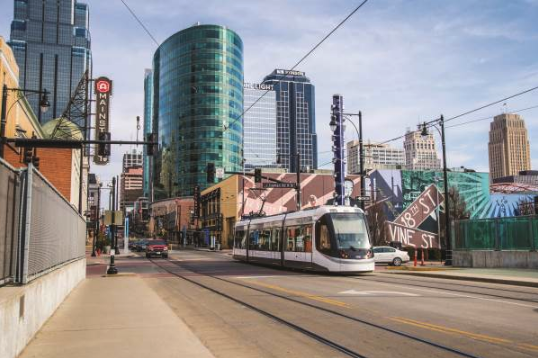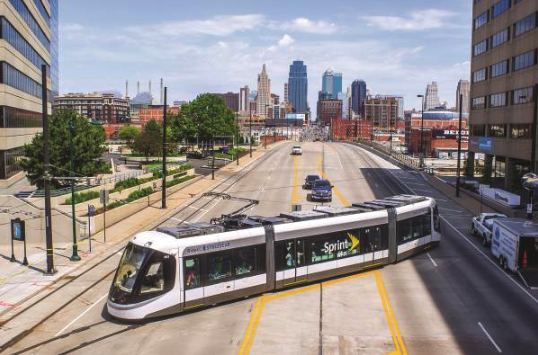For proof public transport can revitalise a city, simply look to the Kansas City Streetcar. Backed and managed by local citizens, the success of this project has led to business, tourism and education bouncing back in the city’s downtown area.

When riding Sydney’s light rail system, its smooth operation and seamless integration with other modes of transport make it easy to overlook the hard work and imagination that lies behind the project. The City of Sydney has had it easier than some other cities, however, with locally based rail experts lending their skills and knowledge to future systems such as the CBD and South East Light Rail Line.
Kansas City in Missouri, US, on the other hand, has had to start from scratch when developing its own light rail system, the KC Streetcar, after ripping up its own rail lines more than 60 years ago. IPWEA spoke to Jason Waldron, Associate Director of Multimodal Transportation, to see how the city has focused on seeing transportation as moving people instead of vehicles, while managing to roll out a transport system which by all measures has been a resounding success.
It is clear Waldron had immense pride in the streetcar system, which has doubled its projected ridership, incorporated a range of innovative technologies, allowed the city’s downtown area to flourish, and seen a re-emergence of public transport amongst a community that has traditionally been very car focused.
Taking five years to plan and build, the KC Streetcar opened in 2016. Free to ride for passengers, the sleek, modern streetcars run along a 3.5km route mostly following Main Street through four neighbourhoods in Kansas City’s downtown area: the riverfront, central business district, arts district, and convention and visitor district. It is the first phase of a wider transport network with at least two expansions planned that would add an extra 6.4km and connect areas further afield such as the University of Missouri-Kansas City to the south and the Berkley Riverfront Park to the north.
There and back again
The current streetcar system is not the first time Kansas City has used this form of public transport. In the 1880s, the city started construction of its first cable car system, which eventually expanded to more than 480km of track, becoming the third largest in the US. In 1913, the city switched from cable cars to electric streetcars, which were easier to construct and maintain. These were the dominant form of public transport until the rise of the automobile resulted in their eventual decline. The last streetcar ran until 1957, when the tracks were ripped up and paved over.
“Automobiles were starting to become very affordable for the average US citizen. As car ownership became more popular, the ridership on the streetcar system declined until eventually it was shut down,” Waldron says.
Making tracks

Bringing the streetcar back as a “re-emerging technology” was first considered after Kansas City made a commitment to revitalise its downtown area. Urban sprawl, driven by cheap property prices, meant people were moving to the suburbs, leaving central parts of the city more deserted.
“The city wanted to have more retail, more residency, more things going on in the downtown inner core of the city that gave people more reasons to move back and move their businesses there,” Waldron says.
The city’s greater population just wasn’t ready for a wide rail network, however, with locals voting nine times against a broader rail system. However a group of advocates from downtown, who had voted in favour of the rail network on each occasion, approached elected officials and the city council and announced their eagerness to have a circular streetcar system installed.
“We had an area that wanted it and it fit into our goals of revitalising downtown. We put it in with the expectation that it would work, and it worked beyond our expectations and projections.”
Missouri’s Transportation Development District (TDD) system also played a critical role in the KC Streetcar’s construction and operation. The TDD Act, a state statute enacted in 1990, allows those within specially designated TDDs to vote on the imposition of certain taxes to fund transportation-related projects. Advocates for the streetcar voted in favour of additional sales and property taxes, which could cover capital and operating costs. It is through the TDD that passengers can now ride the KC Streetcar for free, as local businesses and property owners have promised to absorb the fares for 20 years.
From 2011 to 2016, the KC Streetcar was planned and built. This was “lightning fast” for a system like this in the US, Waldron says with public works, government officials, stakeholders and the community working together to open the streetcar quickly, safely and efficiently.
“We had a really good team, we had a really good design, we had a great construction group, we got lucky with weather and it just all came together.”
“One of my favourite descriptions of the system is that one school calls the streetcar their ‘hallway’.”
A ride for all ages
The KC Streetcar turns about one million rides every six months, doubling expected projections, with an uptick in ridership seen across a range of demographics. As well as youth, who are less driven to get their licence or own a car, the streetcar also attracts more sophisticated young professionals who are moving downtown for the urban lifestyle. Thanks to continual development, it is now possible to live, work and play in the area surrounding the streetcar system.
“Quite frankly, there are people living in Kansas City who don’t own an automobile. That just wasn’t very prevalent before we put in the streetcar,” Waldron explains.
Baby boomers have also benefited from the streetcar system. Historically relocating to states such as Florida or Nevada for retirement, more empty nesters are now moving to Kansas City thanks to the KC Streetcar, which keeps transport options open for older residents and is accessible for those who no longer feel comfortable driving.
If you build it…
The KC Streetcar has also encouraged the development of nearby businesses and amenities. It is this topic that gets Waldron most excited as he discusses how the area has changed.
With the city’s commitment to downtown revitalisation, more than retailers, movie theatres and other commercial enterprises have appeared. Waldron’s top example is that primary schools, grade schools and high schools have started to pop up in the area.
“One of my favourite descriptions of the system is that one school calls the streetcar their ‘hallway’. They’re a school set in an urban setting. They don’t have a library so they’ll jump on the streetcar to go there. They don’t have a playground so they’ll jump on the streetcar to go to a nearby park,” he says.
In terms of economic development, US$2.2 billion has been invested in the area around the streetcar corridor since 2014, with Sly James, Mayor of Kansas City, saying that a “heck of a lot” of that was attributed to the streetcar system. Development has also seen an increase of 58% in the city’s tax revenue.
In another first for the city, a hotel currently being built along the streetcar line did not request a city subsidy or tax breaks, and will have no parking associated with it.
“People are just going to be dropped off by Uber or taxis and they will use the streetcar to get around downtown. The hotel also felt like their economic model didn’t require a subsidy. That’s a big change for us in Kansas City. It certainly lets us know that this revitalisation is happening.”
The road to a smarter city
The KC Streetcar has acted as a catalyst, encouraging Kansas City to look to Sydney and other locales on how to become a smart city, using data to improve services for stakeholders and citizens. Positive disruption and a newly created Innovation Office have promoted a number of tech additions along the corridor, including free Wi-Fi on the streetcars and digital kiosks at each stop.
Traffic lights along the route are also optimised to prioritise the streetcar thanks to an adaptive traffic system proposed by local business. Using algorithms and historical data, combined with cameras that can recognise different vehicle types, information fed into the system gives streetcars ‘preferential treatment’ at intersections over cars and other vehicles depending on the need.
Efficient management of limited right-of-way and an increasingly valuable kerb line was also prioritised, with the city combining bus and streetcar stops along the route. To do so, while keeping both modes of transport accessible to those with wheelchairs, strollers and crutches, multi-level platforms were built.
“What we didn’t want was the entire corridor filled with stop after stop, whether bus or streetcar. We wanted to preserve some parking and just avoid clutter,” Waldron says.
“It’s just like any other emerging or re-emerging technologies – you compare notes and see what lessons everybody can learn from one another.”
The streetcars themselves are also the first in North America to operate with 100% low floor, meaning a passenger can walk from one end to the other without taking a step up or down.
Rounding the learning curve
As well as introducing the physical infrastructure and technology, Kansas City has also had to create its very own transit organisation from the ground up.
Assistance was garnered from federal grants and oversight to ensure the final system operated safely and efficiently.
Consultants and key hires were also utilised to develop the city’s technical capacity.
The TDD was handed its own authority to handle day-to-day activities and manage finances coming in through the streetcar system. This authority was established after the TDD expressed a desire to play an active role in the governance process, taking care of funds produced through any additional taxes paid.
Connecting with peer cities such as Sydney, Portland and Dallas, which already have fully functioning transport systems, has also been critical in building Kansas City’s transit organisation and helping the KC Streetcar reach its current level of success – all done through a truly global effort.
“The peer network to me is really important when you start a new mode of anything,” Waldron says.
“That advice isn’t just for streetcars or even just for transportation. It’s like any other emerging or re-emerging technology – you compare notes and see what lessons everybody can learn from one another.”
This story was first published in the November/December edition of inspire magazine. Read the original and more here.